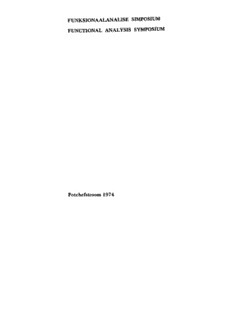
Proceedings of Functional Analysis Symposium. Potchefstroom 1974 PDF
Preview Proceedings of Functional Analysis Symposium. Potchefstroom 1974
FUNKSIONAALANALISE SIMPOSIUM FUNCTIONAL ANALYSIS SYMPOSIUM Potchefstroom 1974 FUNKSIUNAALANALISE Voordragte gelewer tydens 'n simposium aangebied deur die Departement Wiskunde en Toegepaste Wiskunde van die P.U. vir C.H.D. in samewerking met die Suid-Afrikaanse Wiskundevereniging 22, 23 Julie 1974 FUNCTIONAL ANALYSIS Lectures given at a symposium presented by the Department of Mathematics and Applied Mathematics of the P.U. for C.H.E. in collaboration with the South African Mathematical Society 22. 23 July 1974 VDDRWDORD Hierdie publikasie spruit voort uit die simposium oor Funksionaal- analise aangebied aan die Potchefstroomse Universiteit vir C.H.U. in samewerking met die Suid-Afrikaanse Wiskundevereniging. Dit bied 'n beeld van die verrigtinge van die simposium deur middel van geskrawe weergawes van al die vnordragte wat hier gelewer is. Ons waardering gaan aan die WNNR vir die inisiatief om besoeke van buitelandse w15kundiges te organiseer en grootliks 00k ta finansier. Langs dié weg kon prof. A.C. Zaanan uit Nederland in 1974 Suid-Afrikaanse universiteite besoek. Up die simposium was hy ons hoofreferent. Ons bedank hom graag vir sy oriéntaranda en insiggewende voordragte. an oak vir die waardevolle same- sprekings wat met hom gevoer kon word. Verder is ons dank verskuldig aan almal wat voordragte tydens die simposium gelewar hat. asook aan hulle wat deur hulle taanwoordig- haid meegewerk het om daarvan 'n sukses te maak. Aan die owerheid van die P.U. vir C.H.U. rig ons ’n woord van hartlike dank en waardering vir die finansiéle en ander steun wat die aanbieding van die simposium moontlik gemaak hat, sowel as die galeentheid om die simposiumgangers gesellig te kon onthaal. W.P. RDBBERTSE Hoof, Departement Wiskunde en Toegepaste Wiskunde P.U. vir C.H.O. INHUUDSUPGAWE/CDNTENTS A.C. ZAANEN: Riesz spaces and normed Kathe spaces W. KOTZE: Function algebras with maximal ideal space a Jordan curve or are ..... ..... 22 J.C. ENGELBRECHT: Die orde van die Fredholm-determinant vir integraaloperatore in Banach-funksieruimtes 23 G.R.A. GILMDUR: Zero-set spaces and function rings 33 N.J.H. HEIDEMAN: Lipschitz spaces of functions on the surface of the unit sphere in Euclidean n-space 39 P. VAN ELDIK: Enkele eienskappe van integraaloperatore in Banach-funksieruimtes ..... 45 I. BRDERE: Digte deelversamelings van parsieel-geordende versamelings ..... ..... ..... SB J. SWART: Sekere aspekte van veralgemeende nukleére ruimtes ... ..... ..... ..... ..... ..... 64 J.H. WEBB: Extended Schauder decompositions of locally convex spaces u... n-ua- nun-- 71 J.J. GRUBLER: Rate of convergence of certain null sequences in Banach function spaces 73 RIESZ SPACES AND NURNED KUTHE SPACES A.C. Zaanen 1. The non-empty set L[elements f. g. h....] is called a Riesz space if (1] L is a real vector space [ii] L is partially ordered (notation f :_g] such that the vector space structure and the order structure are compatible (1.9., f: gimpliesf+hig+hfor all heL and afiag for all real constants a :_O). [111) the order structure is a lattice structure (1.9., the least upper bound supr,g] and the greatest lower bound inftf,g] exist for all f,gé L]. Simple standard examples: [1] L = R. the space of all real numbers with the usual ordering, [11) L is the space C([a,b]) of all real continuous functions on the closed interval [a,b] ; f i g means that +‘(xJ : g[x] for all xe[a,b]. Returning to the general case, we shall denote the zero-element of L by 0 [there will be no confusion with the number 0); + L = (f: f 3.0] is called the positive cone of L; elements in L+ are called positive elements. Furthennore we introduce the following abbreviations: f+ = sup[F.UJ; f_ = supI-f.0): Ifl = sup(f,-f). The proof of the following formulas is immediate. Addition formula. sup(F + h, g + h) = sup(f.g) * h. Multiplication formula. suptaf, ag] = a suptf,g] For a > 0. The same fonnulas hold with sup replaced by inf. Note further- more that inf(F. g] = -sup (-f,-g] holds for all f, g5 L. By means of these simple formulas we prove the following theorem. Theorem 1. Ebr every fé-L we have f = fi - fr, Ifl = f++fr and inf(f+, f_) : 0. Any element of L is, therefore, the difference of two positive elements (this is sometimes expressed by saying that the positive cone is generating). Proof. we have r + f_ = r + sup[-f, o] = sop(o,+1 = r+. so F = f+-f—. Furthermore [fl = supIt,~f] = sup(2f.U]-f = 2f+-(£+-f') f++f_. Finally. observing that -f_ = inf(f.DJ, f'-+'=rlinftr,01=inrtr+f‘.+‘) = inf(+*,+'). we obtain 0 By definition, the elements f and g in L are said to be disjoint whenever inFI H|.|g|) = 0; this will be denoted by f i g. + _ As an example, it was proved in the theorem above that f J.F holds for every f6 L. For any non-empty subset A of L the
